Borgward-IV teletket (Sd.Kfz.301)
The remote-controlled radio machine of the B-IV type (in the Soviet documents of those years it was called the "teletanket") was a small tracked vehicle controlled by radio from a conventional tank (T-III, T-IV, etc.) and carrying board discharged container with an explosive charge. The machine was intended for blasting, as well as reconnaissance of the area and the enemy.
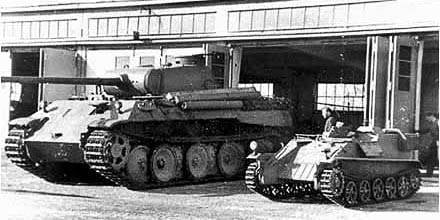
According to the provisions of the “Temporary Instruction on the Use of Radio Tubes”, the command of the Wehrmacht defined the following list of tasks to be accomplished using machines of type B-IV:
intelligence reconnaissance of the enemy before the first tank echelon in the zone of advance of tank formations, by summoning anti-tank weapons and revealing minefields;
reconnaissance of the area in order to determine its patency (swamps, steep slopes, hollows, anti-tank ditches, blind ravines, etc.);
destruction of long-term fortifications and field-type structures;
destruction (blasting) of heavy tanks of the enemy;
undermining bridges and other structures if it is impossible to use sappers for this;
destruction of enemy manpower (within a radius of up to 40 meters - a slaughter action, up to 80 meters - a temporary decommissioning.)
In later documents to the list of tasks solved by machines of type B-VI. added such as degassing the area and blinding the enemy by setting smoke screens. When using a machine for degassing a locality, degassing equipment was placed in a container instead of an explosive. For smoke terrain on the tank shoes were installed for the device smoke.
Serial modifications
There were three serial modifications of the teletket B-IV.
Sd.Kfz.301 Ausf.A
The main difference from the other cars is the crawler tracks with rubber pads, which were replaced with other tracks (without pads) on Sd.Kfz.301 Ausf.BC. The drive wheel had cylindrical rollers instead of teeth and was arranged according to the same type as the drive wheel on the “Hanomag”. A Borgward 6M 49 HP engine was installed on the machine. (according to German data, the Soviet tests in Kubinka showed a different power - 50 HP, in the future, the article will include data obtained on the NIBTPiggon in Kubinka during the testing of the Sd.Kfz.301 Ausf.B teletronic, they differ slightly from some editions ). Combat weight was 3,45 tons. Manufactured 616 machines, as well as 12 prototypes.
Sd.Kfz.301 Ausf.B
The antenna was moved forward, the changes also touched the chassis, the drive wheel in connection with the transition to the new tracks became an absolutely different type (as in a conventional tank). Manufactured 260 machines.
Sd.Kfz.301 Ausf.C
The machine was installed more powerful engine Borgward 6B power 78 l. with., thanks to which its speed increased to 40 km / h, and the reservation was also increased. All this led to an increase in the mass of the machine to 4,85 tons. The armor itself was 20 mm (both sides, stern and forehead), and the bottom and roof were booked 6-mm armor. In addition, the place of the driver (he drove the car on the march) was transferred to the port side. It was made 305 machines.
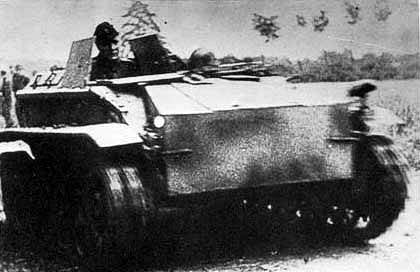
For the movement of the machine during the movements (on the march), manual control was provided, which was carried out by the driver. The machine was controlled by radio by one operator during a battle or reconnaissance.
The radio-controlled wedge B-IV was made on a special base, it had a welded armored body. The body was assembled from sheet metal of various thickness (from 5 to 1 mm). Front sheets were made of rolled homogeneous 8-mm armor, in addition, in later samples, to enhance armor protection, additional 8-mm armored screens were hung on the sides and stern of the vehicle, as well as 8-mm armor shields over the control compartment (in official German documents dated August 1943, it is mentioned that the body of the machine has only frontal armor, apparently it means Sd.Kfz.301 Ausf.A, and not Ausf.B, which was investigated at the NIBTPolygon in Kubinka).
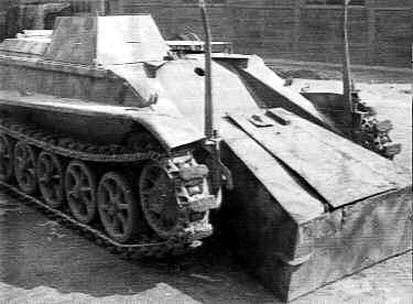
Mass-overall performance of the machine Sd.Kfz.301 Ausf.BAusf.C weight 3,8 tons 4,85 tons length 3700 mm 4100 mm width 1800 mm 1830 mm height 1175 mm 1250 mm track width 1600 mm - the length of the reference surface of the track 95 mm -g -GNUMX mm track width of the track 270 mm is the length of the reference surface of the track XNUMX mm -g –g the mm of the track surface XNUMX mm - the length of the reference surface of the track XNUMX mm - the end of the track mm -
The B-IV was equipped with a 2,25 liter four-stroke six-cylinder carburetor engine with an 50 horsepower. The engine is installed in the aft hull, on the left. The engine was started using a 1 horsepower starter or grip.
The engine power system had a volume of 75 liters (two tanks with a capacity of 45 and 35 liters, respectively). The machine was operated on gasoline with an octane rating of 70 – 74.
The transmission mechanisms consisted of a torque converter and an automatic four-speed gearbox (two gears forward - two back).
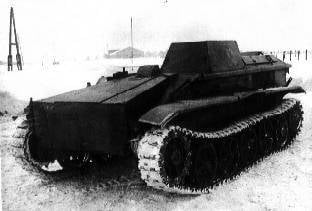
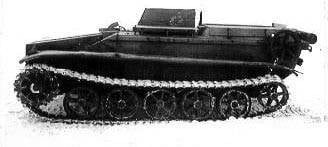
The track chain is small, the width of 205 mm, consists of 75 – 76 tracks. Driving wheels - front, guides - rear. Suspension torsion bar with the location of the torsion shafts on the same axis. Basic skating rinks double with rubber bandages.
The B-IV was equipped with a EP-3 short-wave radio, an electronic decoder and an explosion system relay unit. The radio signal could start and stop the engine, move (forward and backward), change the speed, turn and stop the car, reset and blast the charge. The voltage of the onboard network was 12 Volts.
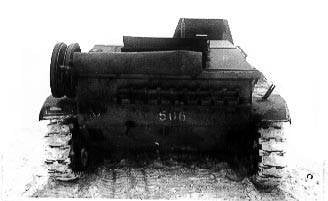
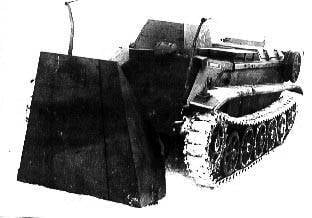
The dumping of a container with an explosive (the weight of an explosive was 500 kg) and its demolition were carried out by radio by closing an electric fuse circuit. To discharge the container with an electric fuse, the tie-bolts of the container were broken, which, in turn, rolled under its own weight from the front inclined sheet. The system of automatic detonation (self-destruction) of the teletketki was provided with the container when it hit the mine (under the influence of the blast wave, two contacts were made and an electric signal from the small battery went to the fuse).
To prevent unauthorized blasting of a container with an explosive (for example, during transportation at the location of its troops), a kind of fuse was used, representing an explosion electrical circuit blocker, preventing explosive from exploding until the car left for a certain (predetermined by the operator) distance (from 0) to 900 meters). When a teletanket hit a mine with an active blocker, an explosive placed in a container could only be undermined by the impact of a detonation (blast wave) from the mine on it (the automatic detonation device does not function in this case).
maximum speed 38 km / h depth of overhanging ditch to 1,35 m height of overcoming vertical wall to 0,45 m maximum rise of 0,35 m depth of overcoming 0,8 m ford average specific ground pressure 0,49 kg / cm² travel range for fuel at an average speed of 20 km / h 150 km radio control radius to 1,5 km
The following measures have been proposed by the specialists of the GBTU of the Red Army to combat telet shoes:
The teletket must be destroyed at a distance no closer than 100 m from the person and 20 meters from the tank ...
The main means of dealing with a teletalker is an anti-tank gun, from a direct shot, and artillery of all calibers ...
Armor-piercing bullets rifle weapons (machine gun, rifle) from a distance 75-50 m side armor punch through ...
A bullet hit the top edge of a container with an explosive can cause it to explode ...
In addition to the undercarriage, the most vulnerable places for disabling, teletketki are the port side from the middle to the stern (engine) and the center of the starboard (radio equipment) ...
Tanks and self-propelled guns, in addition to the destruction of a teletket from a cannon and a machine gun, can counteract it with the help of a maneuver, since when leaving the telet-car's line of attack, the operator, controlling the telet-carriage at a distance, cannot promptly send it behind the tank (ACS) ...
When finding a teletket without a container with an explosive substance, it can be affected in any way and from any distance, since it has no weapons.
Using these proposals, officials of other branches of the military developed their own instructions to combat a new type of weapon.
A further development of this type of machine was the radio controlled machine "Springer" ("Jumper") of the company NSU.
The first B-IV teletketts entered service with the 301 and 302 tank battalions. In their composition teletanketki participated in the Battle of Kursk, during which mainly engaged in mine clearance minefields.
In August, the 1944 of the year, the 301 Tank Battalion entered the 21 Tiger Tank, which were used as control vehicles. The platoon consisted of four tanks: one commander and three control vehicles, each of which operated three B-IV tankettes.
On 15 July, the 1944 of the 302 Tank Battalion had a structure similar to that of the 302. The company consisted of two platoons, and the platoon consisted of 4 ACS StuG 40 G: one of them was commanding, and three managed four teletanketkas each, also a platoon, as in the 301 tank battalion, included the Sd.Kfz armored personnel carrier .251 / 1 Hanomag carrying nine B-IV telescopic driver mechanics. In addition, each platoon had a B-IV X-Telecom in reserve. It is also worth noting that the French battleships Renault UE were in service with the 12 Battalion, in which capacity they were used we do not know, but one such vehicle was captured by Red Army units in January 302 of Warsaw, along with B-IV telet shoes, loaded onto railway platforms. Apparently, she belonged to the 1945 tank battalion, since the photo was presented by the self-propelled guns StuG 302 G.
These teletketki were also in service with the 301 and 302-th tank battalions at a time when these units participated in the suppression of the Warsaw Uprising. Machines used to undermine the rebel baricades. Part of them in January 1945 was captured by the Red Army units directly on railway platforms.
On 1 in March 1945, the X-NUMX B-IV telet rackets were in service.
In addition to the use for its intended purpose, Sd.Kfz.301 was used as a conventional armored transporter and even as a kind of ACS. At the end of the war, some of these teletackets were converted into improvised tank destroyers. One such SPG was captured in full repair by units of the Red Army in the center of Berlin near the Brandenburg Gate. This machine was armed with three grenade launchers for setting up a smoke screen, and for firing at the tanks an improvised installation was installed on it, which was six Pantserechrek pipes fired with 88-mm rocket projectiles. Unfortunately, we don’t know anything about the effectiveness of this tank destroyer, but, apparently, it could only be effective as a vehicle operating from an ambush on city streets, but no more. Also known are the photographs of a destroyed similar SPG, armed with four 88-mm “Panzershrekami”. This car had its own name "Vanza".
Guidelines for combating German radio-type "B-IV" (from February 19 1944 of the year)
The T-type “B-IV” tanket has the following characteristic: height — 1,25 m, width — 1 m, length — 3,36 m, weight — 3,6 t. The permeability in terrain is equal to the T-III tank. The reservation is very insignificant, only frontal armor is not penetrated by armor piercing bullets. The tankette has no armament, but it is equipped with a smoke exhauster and carries an explosive charge - a torpedo in 450 kg.
The peculiarity of the B-IV tanket is that it can be controlled not only by a person (the driver in the wedge heel), but also by radio (the driver outside the wedge).
In the latter case, the control is carried out from a T-III, T-IV tank or assault guns equipped with a special radio control device. The radius of the radio control reaches 2000 m. Each tank control directs the actions of only one radio station.
The series bag is designed for:
for reconnaissance of defense in front of a tank attack by calling on themselves to fire and detect mines by undermining the tankette itself;
to explore the area in front of our leading edge and to establish its cross-country ability;
to remove obstacles on the ground and on the roads by their blasting;
for destruction (blasting) of long-term fortifications, bridges and other objects;
for the destruction of heavy tanks by exploding during a ram attack.
A wedge explosion is dangerous for manpower within a radius of up to 80 m.
Radio tank units usually operate as part of tank or motorized divisions. The smallest combat unit is a platoon - at the same time 4 tankettes act; the largest unit that is fully deployed is a company - at the same time 10 tankettes operate.
The terrain, pitted with craters from air bombs and heavy shells, trenches and trenches, as well as semi-closed terrain makes it difficult to use tankettes. The marshland, as well as the forest and thick tall shrubs make their use impossible.
German instruction requires that the result of the actions of the radio tanket be immediately used by the advancing troops. Thus, the appearance of tankettes on the battlefield signals a tank attack following them soon in this sector of the front.
Easy reservations and the presence on the radio panel of a large explosive charge make it very vulnerable. The fire of anti-tank rifles and even small-caliber guns when firing direct fire easily disables the tankettes at long range.
To parry the actions of the B-IV tankettes, the artillery chiefs take the following measures:
a) The artillery surveillance system immediately reveals the appearance of the radnotankst as they reach their initial lines. The distinctive feature of the "B-IV" is their small size and the absence of fire from the wedge under the approach to our battle formation. These signs should be widely known to the personnel of the artillery units.
Simultaneously with the discovery of B-IV tank shoes, organize reconnaissance of control tanks. Tank management should see "B-IV", so you should look for single tanks T-III or T-IV, standing in half-closed positions behind the line of moving tankettes at a distance of about 1 km.
Reports on the detection of B-IV tank shoes and control tanks should be transmitted immediately through all artillery lines. These reports are also a warning signal about the likely large-scale tank attack of the enemy in this sector.
b) To combat the B-IV tankettes to carry out a general system of anti-tank artillery fire. The main task is to prevent the tanket from approaching our barriers (ditches, escarpments, minefields) or long-term firing facilities to blow them up or to put a smoke screen directly in front of the front edge.
In order not to open the anti-tank fire systems, the destruction of the B-IV tank shoes should be carried out by pre-selected weapons from the anti-tank areas of the first line, mainly 45-mm or 57-mm guns with the most experienced and well-prepared calculations.
The Germans provide the tankets with fire weapons that have the task of destroying guns engaging in combat with B-IV, so batteries standing in closed fire positions must be prepared to suppress the fire support vehicles of the tanket shoes at the start of their activities.
Dedicated guns to open fire from the moment of approach of the radio tanket to the maximum range of actual fire by direct fire. Shooting by the general rules of firing at tanks. For the calculation of the lead, the practical combat speed of the tankettes should be considered equal to the speed of the T-III tank. The defeat of the tanket is achieved either by destroying the undercarriage, or by hitting the hull, disabling the receiving control system or by blowing a torpedo on the wedge.
c) In the case of a smoke exhaust, fire on the radio panel should be carried out until the destruction of the smoke apparatus, regardless of whether it has lost mobility or not.
d) To suppress the detected control tanks, to destroy by fire, batteries allocated for this purpose, standing in closed positions. The task of fire is to damage tanks or create conditions that interfere with their normal operation, which will immediately affect the actions of radio tanket shoes and may lead to the loss of their ability to move.
e) On the site of the attack of radio tanks, immediately prepare the fire of most of the artillery weapons, since the direction of action of the B-IV tankettes.
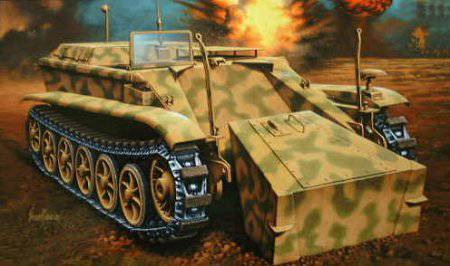
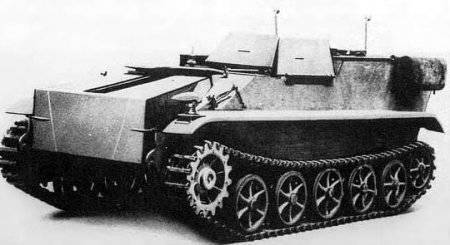
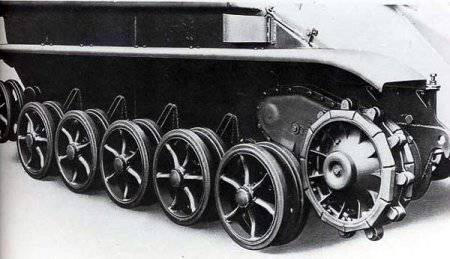
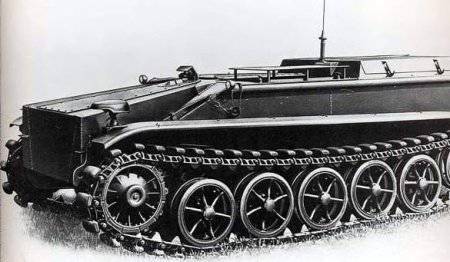
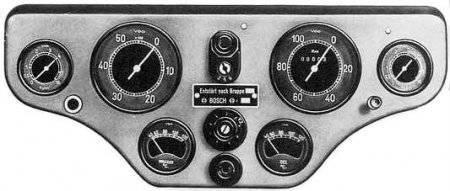
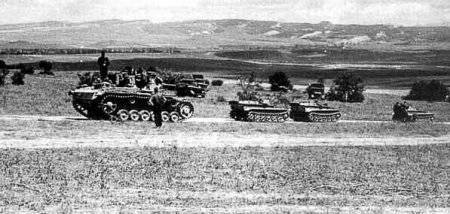
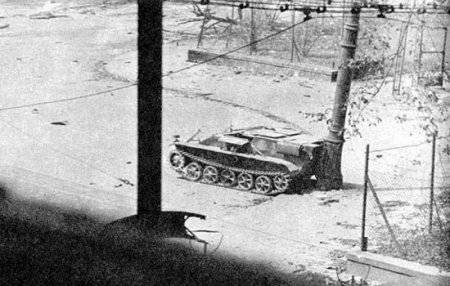
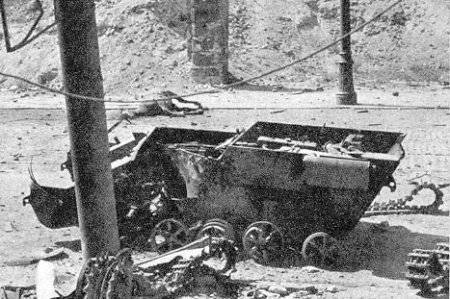
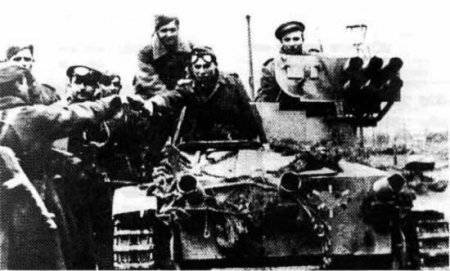
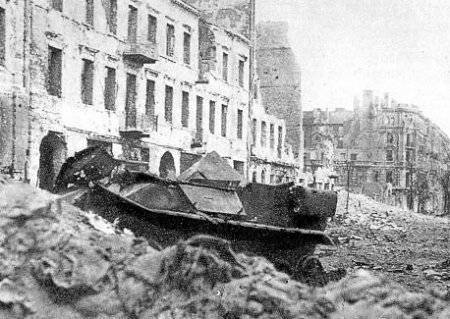
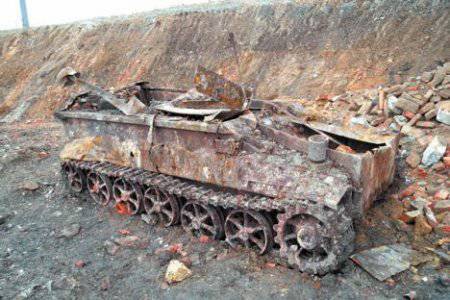
Information